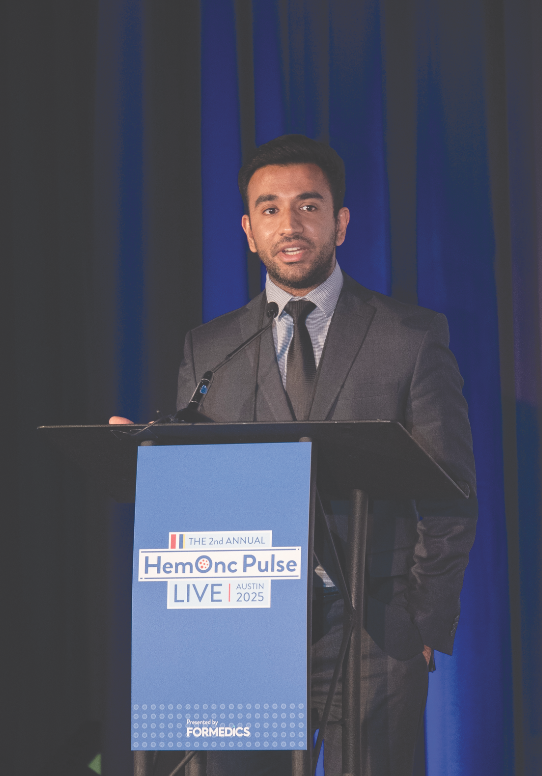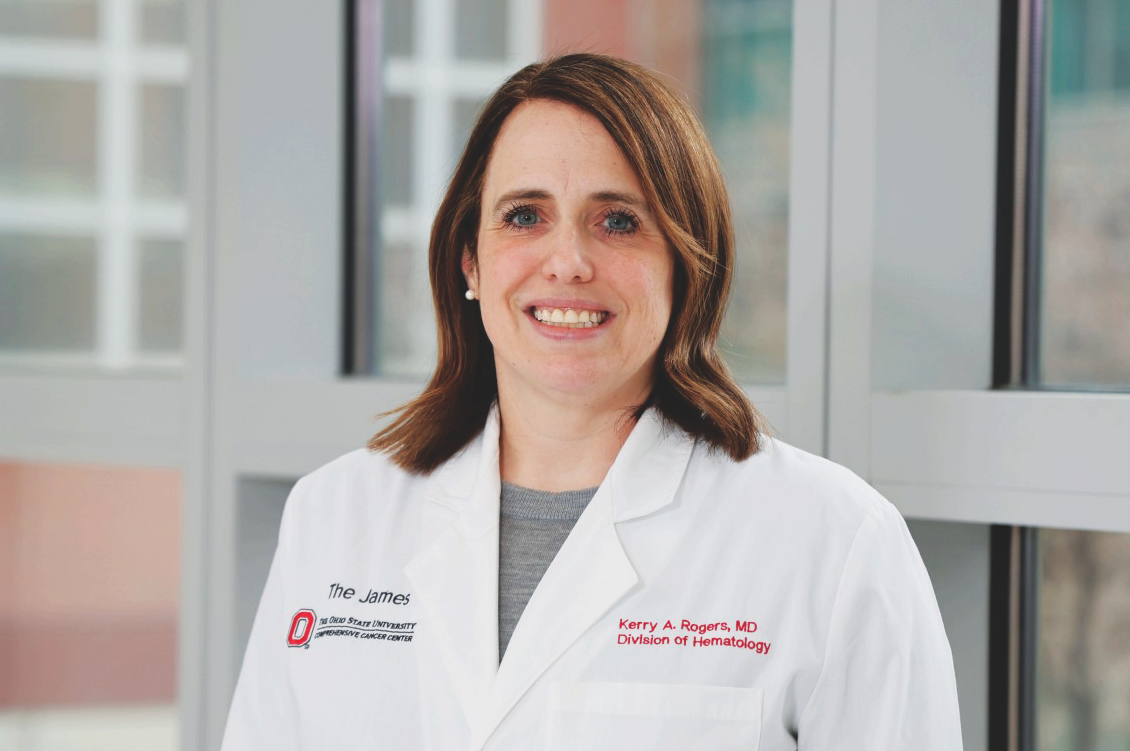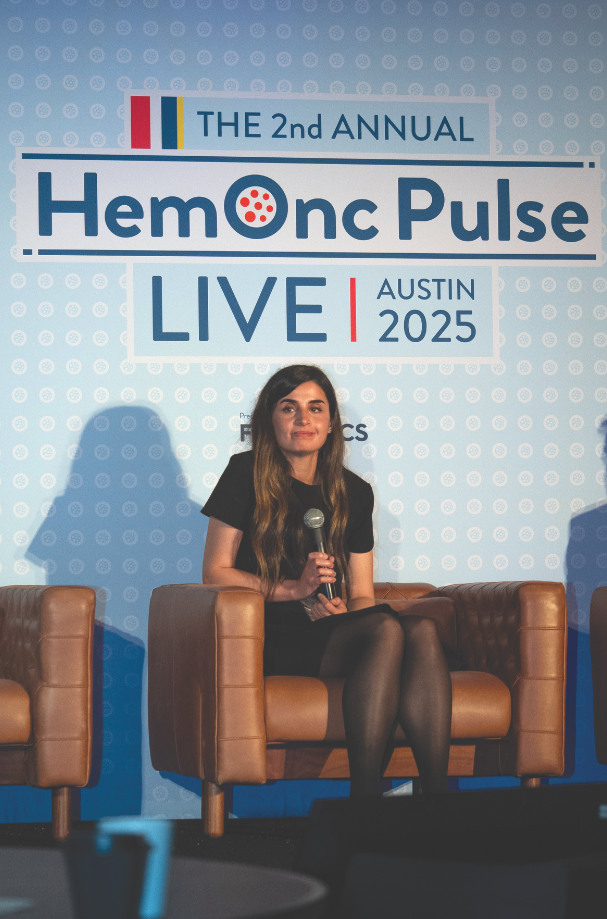
A new era of liquid biopsies for lymphoma may be on the horizon. Critical advances in understanding and detecting circulating tumor DNA (ctDNA) and cell-free DNA (cfDNA) in lymphoma could usher in a future with less invasive, but more informative biopsies.
While ctDNA testing has yet to be used routinely in a clinical setting, hematologic oncologists are evaluating it in multiple contexts across lymphoma subtypes. There are numerous potential applications of ctDNA under study, from diagnostic genotyping to monitoring the disease burden over time, predicting treatment outcomes, adapting therapy, and evaluating post-treatment outcomes.1–3
“I think ctDNA is a really exciting, noninvasive, real-time biomarker tool that’s become a very active area of research in lymphoma,” said Swetha Kambhampati, MD, an Assistant Professor in the Division of Lymphoma at the City of Hope in Duarte, California.
A common overarching goal that unites the many potential applications of ctDNA is gaining information about a patient’s disease that can be used to tailor therapy.
“You can detect tumor-associated mutations in the blood pretty reliably and get a decent genotype of a patient’s tumor, and that can inform you about the patient’s biology,” said Alex Herrera, MD, an Associate Professor in the Division of Lymphoma at the City of Hope. “As we develop more targeted therapies, that can be instructive and help us think about personalizing therapy.”
The idea of using ctDNA as a biomarker in oncology dates back multiple decades. A 2001 review article4 stated that “circulating nucleic acids might eventually be used for the development of noninvasive diagnostic, prognostic, and follow-up tests for cancer.”
However, researchers have gained a greater understanding of its biology in lymphoma in recent years, which has helped paint a larger and more detailed picture of its potential applications.
For one, it’s become clear that “virtually all cases of lymphoma,” including early-stage disease, have measurable levels of ctDNA in the peripheral blood and that genotypic profiles in ctDNA “strongly correlate with profiles in tumor tissue,” according to a 2022 review article written by lead author by Mark Roschewski, MD, a Senior Clinician and the Clinical Director of the Lymphoid Malignancies Branch of the Center for Cancer Research at the National Cancer Institute in Bethesda, Maryland.3
“We first started studying the role of ctDNA in aggressive B-cell lymphomas in 2014 and things have evolved quickly,” Dr. Roschewski told Blood Cancers Today.
Since that time, the field has “learned fundamental principles related to the potential utility of ctDNA at baseline, during therapy, at the end of therapy, and after therapy,” Dr. Roschewski said. He believes these principles are “unlikely to change,” and they “appear to be true across other lymphoma subtypes as well.”
As clinicians and researchers learn more about the biology of ctDNA in lymphoma, the field is also witnessing parallel progress in another area.
“A second major advance is that the technology continues to improve, and the analytical sensitivity of the new assays is much improved,” Dr. Roschewski said. “This allows additional questions to be asked and they are the focus of clinical trials now.”
Using ctDNA to Ask Questions
While a mutation profile “can never replace the gold standard of pathological tissue-based diagnosis,” liquid biopsies may have a “huge advantage over tissue biopsies because they allow serial testing and are considered a ‘real-time’ snapshot of disease burden,” Sarah Huet, PharmD, PhD, and Gilles Salles, MD, PhD, both from the Université Claude Bernard Lyon 1, wrote in a 2020 publication.1
The ability to capture serial samples in a noninvasive fashion has created new avenues for research, allowing investigators to capture dynamic changes in ctDNA before, during, and after treatment. While many studies have conducted retrospective analyses of ctDNA, the pivotal phase III POLARIX trial prospectively evaluated ctDNA in patients with diffuse large B-cell lymphoma (DLBCL).5
The trial, which resulted in the approval of pola-R-CHP in the frontline setting for patients with DLBCL,6 evaluated ctDNA in paired baseline and on-treatment plasma samples from patients with DLBCL who were receiving pola-R-CHP or R-CHOP.
The investigators, led by Dr. Herrera, measured patients’ plasma ctDNA levels at baseline and during the first day of the second cycle of treatment. They used the Roche Avenio Non-Hodgkin Lymphoma Cancer Personalized Profiling by Deep Sequencing (CAPP-Seq) assay to measure ctDNA.
The study showed that patients with baseline ctDNA levels above the median had shorter progression-free survival (PFS) and overall survival (OS) than those with baseline ctDNA levels below the median.
“More importantly, we showed that changes in on-treatment ctDNA—[through] dynamic assessment of ctDNA—were associated with outcomes,” Dr. Herrera said. “That was prognostic.”
For example, patients who showed larger reductions in ctDNA levels after one treatment cycle had longer PFS and OS than those who had smaller reductions in ctDNA levels.5
“Patients who achieved a significant decline in their ctDNA had better outcomes, whereas patients who did not have a twofold log drop—which was our threshold—had poor outcomes,” Dr. Herrera said.
However, he emphasized an important caveat to those results.
“The reality is—even though the findings were significant, and they were a decent discriminator of who was likely to do well or not well with the therapy—there were still a majority of patients who didn’t achieve a twofold log drop [and] actually appeared to do fine,” Dr. Herrera said. “They were still cured due to therapy.”
An abstract Dr. Herrera and colleagues presented at the 2023 ASCO® Annual Meeting built upon those findings, showing that achieving ctDNA negativity at day one of cycle five and the end of treatment were also prognostic for longer OS and PFS.7
While more questions remain, the POLARIX trial can inform the design of future studies that prospectively evaluate ctDNA.
“Even though this was a promising validation of something that we’ve studied for many years and primarily done in a retrospective way, I still think there’s room to improve,” Dr. Herrera said.
Beyond DLBCL, ctDNA is also under study in other subtypes of lymphoma.
For example, research by Dr. Roschewski and colleagues has shown that early changes in ctDNA are associated with outcomes in patients with treatment-naïve mantle cell lymphoma (MCL).8,9
In a recent study, they analyzed ctDNA dynamics in patients with previously untreated MCL who received induction therapy with bortezomib and DA-EPOCH-R for six cycles.9 They randomly assigned patients who responded to therapy to receive bortezomib maintenance or undergo observation.
The researchers collected serum samples before treatment, after an initial bortezomib treatment window, after cycles one and two, at the end of induction, and at each follow-up visit. They used next-generation sequencing (NGS) to identify and quantify ctDNA in the serum samples.
Patients who did not have detectable ctDNA after two cycles of induction had significantly longer PFS and OS compared with those who had detectable ctDNA. These results suggest that “interim ctDNA negativity strongly correlates with improved survival and supports the investigation of response-adapted strategies,” the study’s authors concluded.9
The findings, combined with other emerging data on ctDNA in MCL, have big-picture implications that can inform the design of future studies.
“These concepts can be applied to clinical trials now where these biomarkers can identify patients who are responding to therapy compared [with] those with more resistant disease,” Dr. Roschewski said.
While the body of research on ctDNA in aggressive lymphomas has been expanding, there’s still much to be done in other subtypes.
“We do need more data and a validated strategy in other types of lymphomas, particularly for indolent lymphomas and Hodgkin [lymphoma],” Dr. Kambhampati said.
In follicular lymphoma, which is the most common indolent non-Hodgkin lymphoma, this work is underway.
A recent prospective pilot study evaluated if ctDNA could predict response to therapy and disease progression within 24 months of diagnosis in patients with follicular lymphoma.10 This prospective pilot study represents the “first analysis of both basal and dynamic changes in ctDNA levels that employ longitudinal cfDNA genotyping” in a multicenter cohort of patients with follicular lymphoma.10
It was key to “establish the best moment and the best conditions” in the pilot study to collect the samples, said Margarita Sánchez-Beato, PhD, who was the senior author of the study. Dr. Sánchez-Beato is Head of the Lymphoma Research Group in the Medical Oncology Department and Scientific Coordinator of the Technical Support Units at Instituto Investigación Sanitaria Puerta de Hierro-Segovia de Arana in Spain.
To determine the optimal timing and conditions, Dr. Sánchez-Beato and colleagues prospectively collected basal pretreatment, on-treatment, end-of-treatment, and follow-up plasma samples from patients with follicular lymphoma who received chemotherapy plus rituximab. They performed targeted deep sequencing on cfDNA and tumor genomic DNA from diagnostic biopsy samples.
Nearly three-quarters (73%) of alterations detected in the diagnostic tissue samples were detected in basal cfDNA.10 Furthermore, the study showed that basal ctDNA levels are “associated with the risk of early progression and response to treatment” in follicular lymphoma and that cfDNA “monitoring and genotyping during treatment and follow-up predict response to treatment and early progression.”10
Gaining these prognostic insights early is critical, Dr. Sánchez-Beato said, as they could allow clinicians to make informed decisions about adapting therapy.
“You have this information at the beginning,” she said. “You can decide.”
Dr. Sánchez-Beato also pointed back to another practical benefit of using a liquid biopsy: the ability to collect serial samples.
“If it was a bone marrow biopsy, it would be impossible, but it is viable to take samples of the peripheral blood at different timepoints,” she said.
Does Imaging Have a Complementary Role?
Imaging tests are another noninvasive way to collect information about disease burden at multiple timepoints in patients with lymphoma.
For example, 18F-fluorodeoxyglucose-positron emission tomography/computed tomography (FDG-PET/CT) scans are a “standard at baseline to describe the extension of the disease” and during follow-up evaluations in DLBCL and classical Hodgkin lymphoma, according to an article by Pierre Decazes, MD, PhD, of the Henri Becquerel Cancer Centre and the University of Rouen, and colleauges.11
Furthermore, PET imaging results have been used to adapt therapy in patients with classical Hodgkin lymphoma12 and DLBCL.13
However, a retrospective analysis of patients with DLBCL who received EPOCH with or without rituximab suggests “ctDNA identifies patients at risk of recurrence prior to imaging.”14 The study used a quantitative high-throughput method that combined amplification of immunoglobulin gene segments with NGS to detect ctDNA in serial samples of serum obtained during treatment and follow-up.
“Compared [with] imaging tests, these assays appear to have a major advantage regarding analytic sensitivity,” Dr. Roschewski said.
Beyond greater sensitivity, there are practical advantages to reducing the “scan burden” on patients, clinicians, and health care systems, he said.
Dr. Herrera agreed that scanning patients less would be preferable.
“I’d love to scan patients less frequently or not at all,” Dr. Herrera said.
However, there is evidence that suggests imaging and ctDNA assessments can be complementary tools.
For example, a recent prospective study of patients with newly diagnosed large B-cell lymphoma (LBCL) receiving R-CHOP or similar regimens showed that combining information on the ctDNA load with data on the total metabolic tumor volume from FDG-PET/CT “improved the risk stratification” of patients with aggressive LBCL, “even with a short follow-up.”15
While more research remains to be done on imaging and ctDNA assessments in lymphoma, they may eventually augment one another as noninvasive methods to assess changes in disease burden over time.
“There is a growing trend toward a PET/ctDNA combination to monitor [measurable] residual disease (MRD) in patients … new parameters will become more and more accessible as tumors are increasingly segmented automatically and could help to determine whether ctDNA should replace or be additional data to PET/CT,” Dr. Decazes and colleagues wrote.11
The Path to an ‘Optimal’ ctDNA Assay
As clinicians and researchers elucidate the biology and prognostic value of ctDNA in lymphoma, they see a growing need for further advances in ctDNA assays.
“In an ideal world, we would have perhaps even a more sensitive assay to really help us identify who are the highest-risk patients,” Dr. Herrera said. “Because even here [in the POLARIX trial], it was hard to identify a group of patients who really did poorly enough that you would really want to change their therapy.”
However, designing a ctDNA assay that is both highly sensitive and accurate necessitates overcoming technical and biological challenges.
“Because you have different mutations and markers that may be important in different lymphoma subtypes … it’s hard to do one all-encompassing ctDNA technique,” Dr. Kambhampati said.
An “optimal” ctDNA assay must be able to “efficiently utilize all available cfDNA” while maintaining a low background error profile that allows it to detect low-level signals and be able to “identify the relevant mutations” across lymphoma subtypes, according to Dr. Roschewski and colleagues.3
Polymerase chain reaction (PCR)- or NGS-based approaches are currently used in ctDNA assays, but those approaches fall across a spectrum in terms of sensitivity and potential limitations. For example, digital PCR has a sensitivity of around 1:10,000 but is limited by the amount of available DNA, while CAPP-Seq, an NGS-based approach, has a sensitivity of around 2.5:100,000 but is limited by its error profile.3
Other assays include NGS-based immunoglobulin gene sequencing, Lymphopanel, and whole-genome sequencing. Another approach for “improving the limit of detection” for ctDNA is phased variant enrichment and detection by sequencing (PhasED-Seq).3
Targeted sequencing approaches such as CAPP-Seq and PhasED-Seq also have another potential advantage. They can “move beyond simple disease detection and perform mutational profiling and molecular genotyping,” Dr. Roschewski and colleagues wrote.3
Despite the wide array of ctDNA assays and approaches available, there is more to be done before they enter routine clinical use.
“The most progress in clinical application of ctDNA techniques has been made in DLBCL so far, but we know we need more progress in the other tumor subtypes,” Dr. Kambhampati said.
Plus, with numerous assays and techniques available, there is a need for greater consistency across the board, Dr. Roschewski emphasized.
“The field currently lacks proper standardization of the way these tests are collected, processed, and analyzed,” Dr. Roschewski said. “That creates a gap where different studies are using techniques that may not be equal to other techniques or processes.”
The Journey to the Clinic
Beyond improving assays to measure ctDNA, there are several other steps to be taken along the journey to its wider implementation and clinical use.
“In the future, one hopes to have more harmonization of the standards for collection, processing, and analysis,” Dr. Roschewski said. “Further, these tests are not widely available for clinical use. In part, this is because there is not [a] defined clinical utility but also because [these tests] require central processing and the turnaround time for clinicians is not yet feasible.”
When it comes to adapting therapy based on ctDNA, Dr. Herrera agreed that speed is a critical consideration.
“The obvious and inherent challenge is time,” he said. “If you’re going to adapt therapy based on a ctDNA test, there is a certain requisite amount of time that it takes to run the sample, determine whether there’s ctDNA present, how much ctDNA there is, and then feed that back to the treating physician or the investigator to make a determination about the treatment.”
Another important step along the path to routine clinical use will be ensuring quality and consistency in sample collection and storage.
“Using proper cell-stabilizing tubes can really improve the results, and then having protocols for storage and shipment that are harmonized across centers will further improve the validity of results,” Dr. Roschewski said.
The quality and quantity of the sample is especially important when testing lymphomas that have a lower tumor burden, Dr. Sánchez-Beato said.
“This is one of the critical points, to have samples of the highest quality to perform this assay in a standardized way,” she said. “The amount of peripheral blood to collect is also critical, especially in the case of indolent lymphomas.”
With the array of biological, technological, and logistical challenges, will it be possible for ctDNA to move into the realm of routine clinical practice?
“We have examples of other diseases, such as leukemias and multiple myeloma, where MRD assessment is a standard part of what they do and how they assess the disease to make therapy decisions,” Dr. Herrera said. “I think it’s possible [for ctDNA], but there are logistical hurdles to overcome.”
The field will need to validate assays, standardize practices, and design specific studies to move forward.
“We would require trials that assess ctDNA-guided therapy,” Dr. Herrera said. “If those trials result in an improvement in outcomes for patients, then it’s worth all of the infrastructure and all the logistical challenges.”
If the use of ctDNA and cfDNA does eventually reach the clinic, it could have significant implications for patients and health care professionals alike. For example, if ctDNA could be used to identify the baseline tumor volume and genotype, it could reduce the need for scans or invasive biopsies.
“Patients obviously may still need imaging and other response assessments, but it would be an amazing tool to complement what we already have, and potentially even replace some of the invasive techniques,” Dr. Kambhampati said.
It could also allow patients and clinicians to have a higher level of confidence about the trajectory of the disease and the appropriateness of the current course of treatment.
“If we come up with a validated, reproducible, and accurate method of measuring disease in a noninvasive manner through liquid biopsy, I think this would be incredible from a patient perspective,” Dr. Kambhampati said.
While questions and challenges surrounding ctDNA testing remain, she is optimistic about its applications.
“I think it’s truly remarkable progress that’s been made in the field,” Dr. Kambhampati said. “While a lot more remains to be done, I think we have a better understanding of using ctDNA for tumor quantification, risk stratification, and prognostication so that we can better individualize our treatments for our patients.”
Dr. Sánchez-Beato agreed, emphasizing that her experience studying liquid biopsy in follicular lymphoma has shifted her views on its potential.
“I must say that at the beginning, I was quite skeptical about the value of liquid biopsy,” she said. “But when we began to work with [these] data, [they were] surprising … I am now a believer in the value of liquid biopsy and its future.”
Cecilia Brown is an Associate Editor for Blood Cancers Today.
References
- Huet S, Salles G. Potential of circulating tumor DNA for the management of patients with lymphoma. JCO Oncol Pract. 2020;16(9):561-568. doi:10.1200/JOP.19.00691
- Lauer EM, Mutter J, Scherer F. Circulating tumor DNA in B-cell lymphoma: technical advances, clinical applications, and perspectives for translational research. Leukemia. 2022;36(9):2151-2164. doi:10.1038/s41375-022-01618-w
- Roschewski M, Rossi D, Kurtz DM, Alizadeh AA, Wilson WH. Circulating tumor DNA in lymphoma: principles and future directions. Blood Cancer Discov. 2022;3(1):5-15. doi:10.1158/2643-3230.BCD-21-0029
- Anker P, Lyautey J, Lederrey C, Stroun M. Circulating nucleic acids in plasma or serum. Clin Chim Acta. 2001;313(1-2):143-146. doi:10.1016/s0009-8981(01)00666-0
- Herrera AF, McCord R, Kimes P, et al. Risk profiling of patients with previously untreated diffuse large B-cell lymphoma (DLBCL) by measuring circulating tumor DNA (ctDNA): results from the POLARIX study. Blood. 2022;140(Supplement 1):1297-1300. doi:10.1182/blood-2022-157559
- FDA approves polatuzumab vedotin-piiq for previously untreated diffuse large B-cell lymphoma, not otherwise specified, and high-grade B-cell lymphoma. U.S. Food and Drug Administration. Accessed April 22, 2023. https://www.fda.gov/drugs/resources-information-approved-drugs/fda-approves-polatuzumab-vedotin-piiq-previously-untreated-diffuse-large-b-cell-lymphoma-not
- Herrera AF, Tracy S, Sehn LH, et al. Circulating tumor DNA (ctDNA) status and clinical outcomes in patients (pts) with previously untreated diffuse large B-cell lymphoma (DLBCL) in the POLARIX study. J Clin Oncol. 2023;41(16_suppl):7523-7523. doi:10.1200/jco.2023.41.16_suppl.7523
- Lakhotia R, Melani C, Pittaluga S, et al. Circulating tumor DNA dynamics during therapy predict outcomes in mantle cell lymphoma. Blood. 2018;132(Supplement 1):147-147. doi:10.1182/blood-2018-99-112573
- Lakhotia R, Melani C, Dunleavy K, et al. Circulating tumor DNA predicts therapeutic outcome in mantle cell lymphoma. Blood Adv. 2022;6(8):2667-2680. doi:10.1182/bloodadvances.2021006397
- Fernández-Miranda I, Pedrosa L, Llanos M, et al. Monitoring of circulating tumor DNA predicts response to treatment and early progression in follicular lymphoma: results of a prospective pilot study. Clin Cancer Res. 2023;29(1):209-220. doi:10.1158/1078-0432.CCR-22-1654
- Decazes P, Camus V, Bohers E, et al. Correlations between baseline 18F-FDG PET tumour parameters and circulating DNA in diffuse large B cell lymphoma and Hodgkin lymphoma. EJNMMI Res. 2020;10(1):120. doi:10.1186/s13550-020-00717-y
- LaCasce AS, Dockter T, Ruppert AS, et al. Positron emission tomography-adapted therapy in bulky stage I/II classic Hodgkin lymphoma: CALGB 50801 (Alliance). J Clin Oncol. 2023;41(5):1023-1034. doi:10.1200/JCO.22.00947
- Michaud L, Bantilan K, Mauguen A, Moskowitz CH, Zelenetz AD, Schöder H. Prognostic value of 18F-FDG PET/CT in diffuse large B-cell lymphoma treated with a risk-adapted immunochemotherapy regimen. J Nucl Med. 2023;64(4):536-541. doi:10.2967/jnumed.122.264740
- Roschewski M, Dunleavy K, Pittaluga S, et al. Circulating tumour DNA and CT monitoring in patients with untreated diffuse large B-cell lymphoma: a correlative biomarker study. Lancet Oncol. 2015;16(5):541-549. doi:10.1016/S1470-2045(15)70106-3
- Le Goff E, Blanc-Durand P, Roulin L, et al. Baseline circulating tumour DNA and total metabolic tumour volume as early outcome predictors in aggressive large B-cell lymphoma. A real-world 112-patient cohort. Br J Haematol. 2023. doi:10.1111/bjh.18809






 © 2025 Mashup Media, LLC, a Formedics Property. All Rights Reserved.
© 2025 Mashup Media, LLC, a Formedics Property. All Rights Reserved.